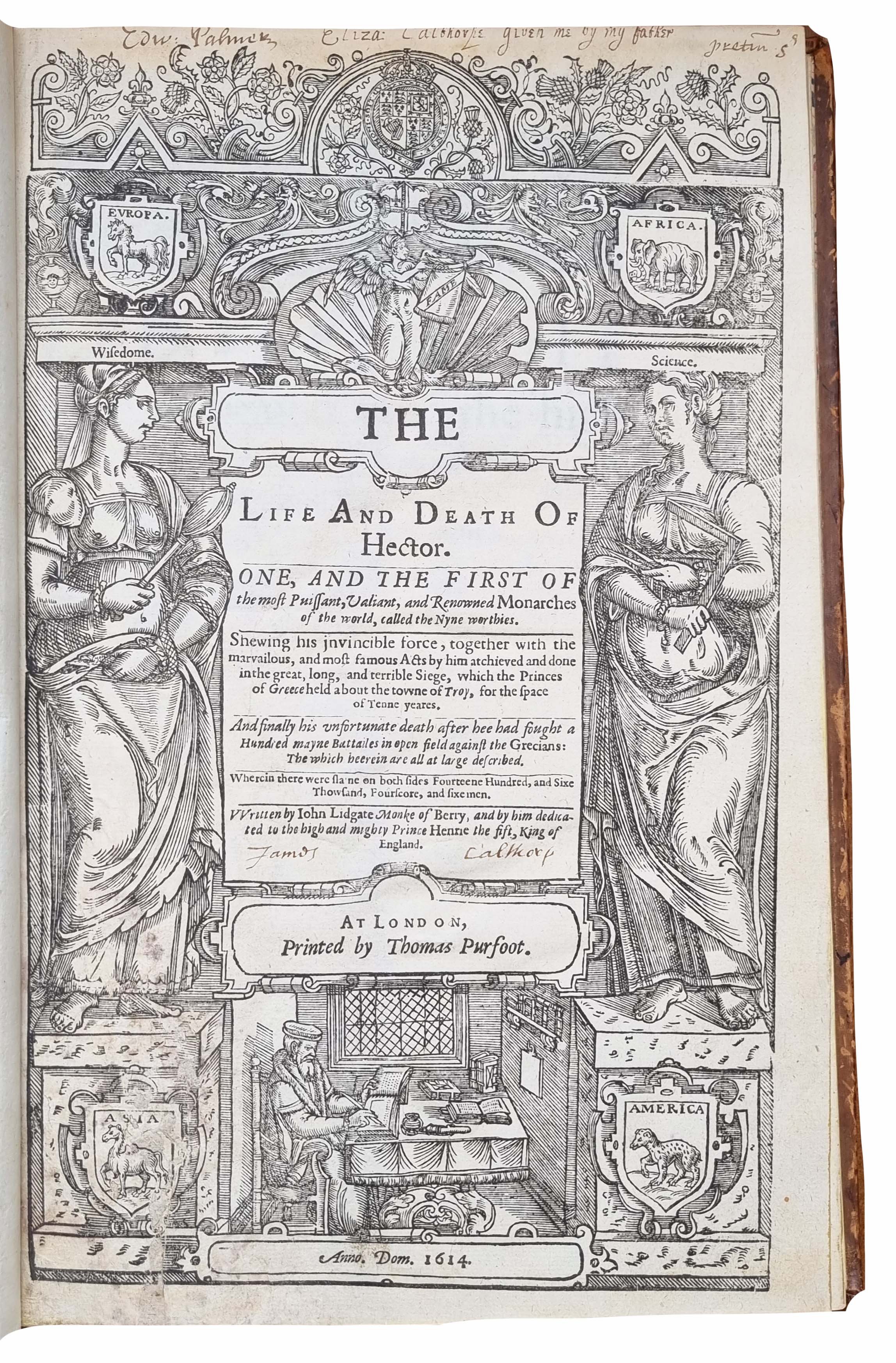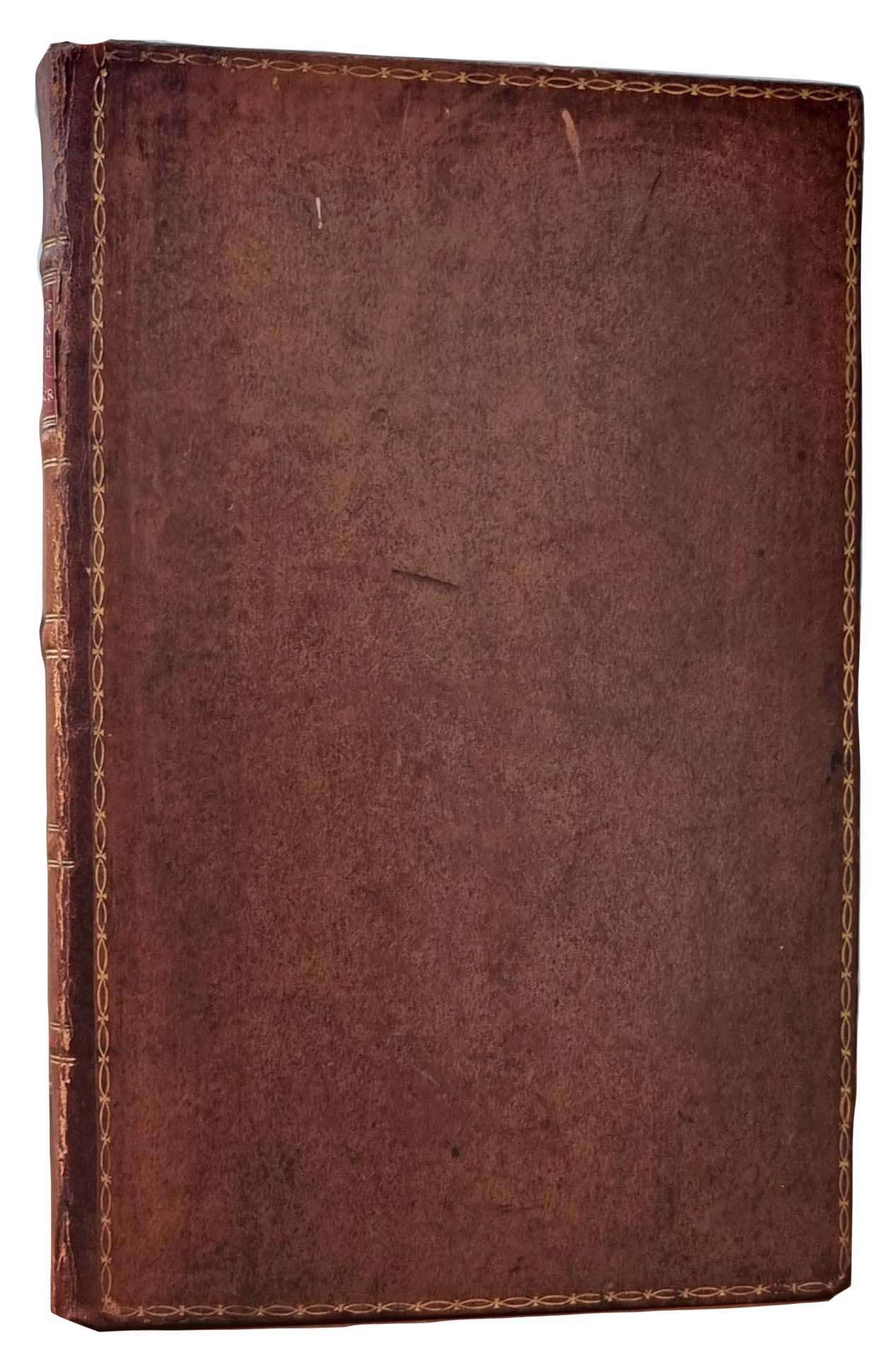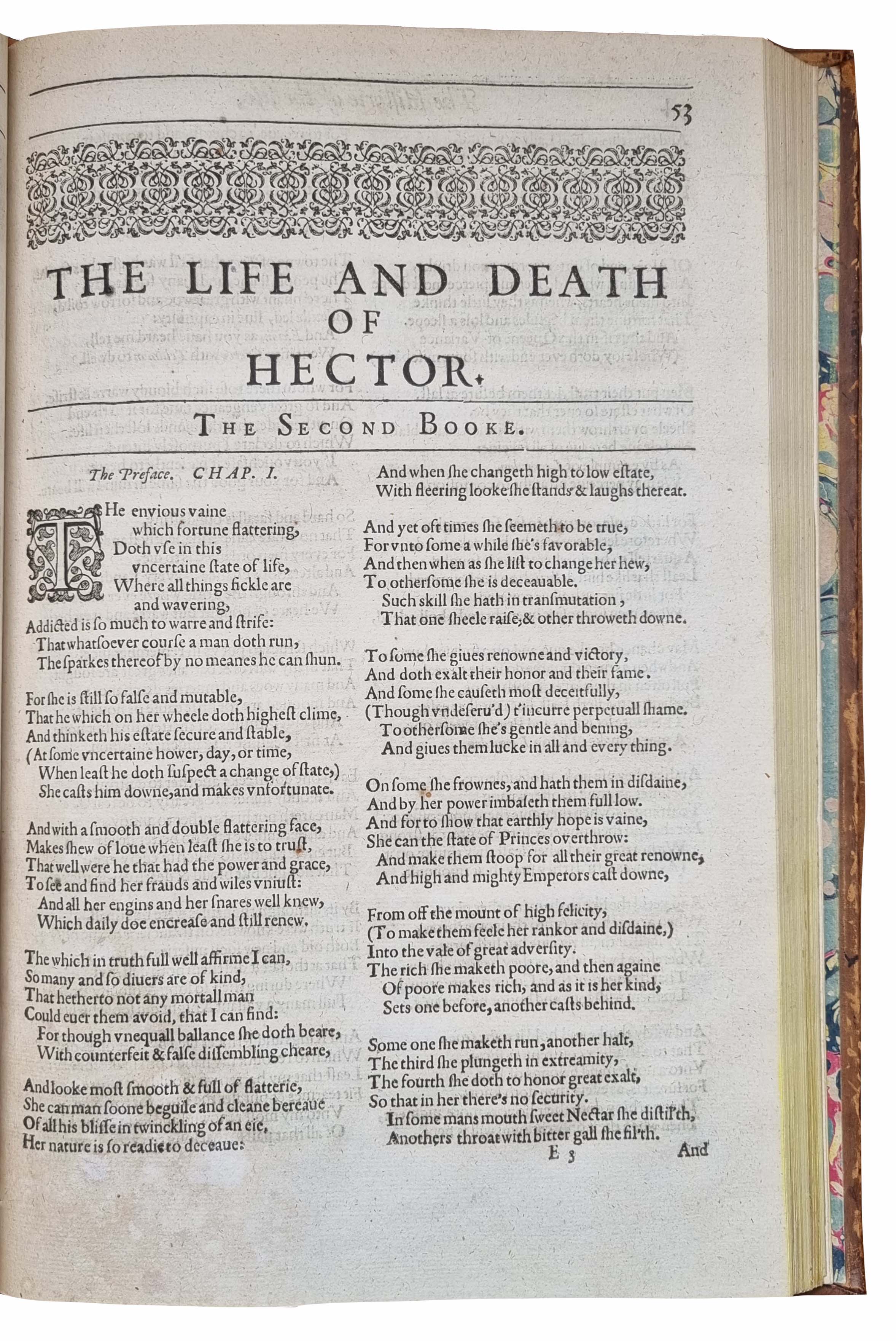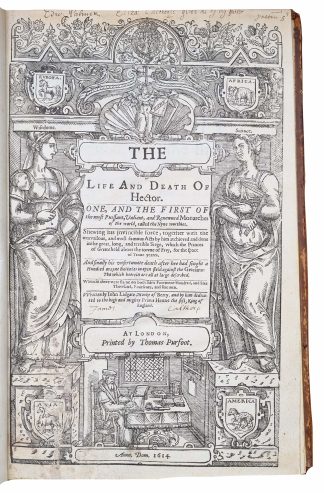LYDGATE, John
A VIRGINIA COPY
The life and death of Hector. One, and the first of the most puissant, valiant, and renowned monarches of the world.
London, Thomas Purfoot, 1614£5,750.00
FIRST EDITION thus. Folio. pp. [xii], 131, 126-318, [ii]. [par.] , A-K , L M-2C , 2D . Roman letter, some Italic, in double column. Title within a large woodcut border, with arms of James I at head, shield devices of Europe, Asia, Africa and America in corners, large figures of Wisdome, Science at sides, author writing in his study below (Mckerrow and Ferguson 130B), floriated woodcut initials grotesque woodcut head-pieces and floriated tail-pieces, typographical ornaments. Contemporary autograph of “Edw. Palmer pretm. 5s”, the Elizabethan antiquary, at head of title, “Eliza. Calthorpe given me by my father” in slightly later hand next to it, autograph of ‘James Calthorpe’ below. Light age yellowing, small defect repaired, on verso, at lower inner corner of title, just affecting woodcut border, damp staining, mould at lower inner corner, especially the first gathering, first four leaves strengthened there with old paper on versos, just touching a letter and two catch words. An interesting copy in C18th calf, covers bordered with a gilt roll, rebacked in match sheep, with raised bands, double gilt ruled in compartments, red morocco label gilt, edges gilt rolled marble endpapers, all edges yellow.
Edward Palmer (c.1555–1624) was a gentleman with antiquarian interests from Gloucestershire, renowned for his extensive collections, notably of Roman coins: William Camden called him “a curious and diligent Antiquarie”. He is best remembered however for his purchase of the then unnamed Garrett Island in the American colony of Virginia (present day Maryland), which he designated for the establishment of what would have been the first university in the English colonies. In 1622, Palmer received a patent for land from the Virginia Company of London. In his will made 22 November 1624, Palmer bequeathed his lands “in Virginia and New England” to his sons and nephew and declared that, should their issue fail, the land would be used for the founding of a university to be called, “Academia Virginiensis et Oxoniensis,” Academy of the Virgin and Oxford. The project died with the embezzlement of Palmer’s treasury after his death. In the same year that Palmer received his patent a youth named Christopher Calthorpe came with Lt. Parfrey Virginia. He was cousin to Nathaniel Bacon (“the Rebel”) sometime President of the Virginia Council. Several members of his family were ‘James’ or ‘Elizabeth’ (they claimed kindred with the late queen) and we have not been able to identify particularly the ex-libris.
Rare edition of this modernised verse paraphrase in six line stanzas, sometimes attributed to Thomas Heywood, of the ‘Troy book’ of John Lydgate, which exercised an influence on Robert Henryson, Thomas Kyd, and Christopher Marlowe, and was one of Shakespeare’s sources for Troilus and Cressida. Lydgate’s original verse dedication to ‘Prince Henry the Fift’ is retained in this modernised version. “Troy Book is one of the most ambitious attempts in medieval vernacular poetry to recount the story of the Trojan war. John Lydgate, monk of the great Benedictine abbey of Bury St. Edmunds in Suffolk, began composing the poem in October 1412 on commission from Henry, Prince of Wales, later King Henry V, and he completed it in 1420. Lydgate’s poem is a translation and expansion of Guido delle Colonne’s Historia destructionis Troiae, a Latin prose account written in 1287 but based, without acknowledgement, on Benoît de Sainte-Maure’s Old French Roman de Troie (c. 1160). Troy Book presents the full narrative and mythographic sweep that the Middle Ages expected for the story of Troy’s tragic downfall. Though Lydgate wrote the poem some three decades after Chaucer’s Troilus and Criseyde, it furnishes the essential background that educated medieval readers would have brought to Chaucer’s poem and to Chaucer’s source, Boccaccio’s Filostrato. .. In the late Middle Ages and Renaissance, Troy Book enjoyed considerable reputation and influence. .. In The Recuyell of the Historyes of Troye (STC 15375), the first book printed in English (c. 1475), William Caxton professes that there is no need for him to translate the portion of his French source, Raoul Lefévre’s Recueil des Histoires de Troie, dealing with the fall of Troy: “And as for the thirde book whiche treteth of the generall and last destruccioun of Troye Hit nedeth not to translate hit into englissh ffor as moche as that worshifull and religyous man dan John lidgate monke of Burye did translate hit but late after whos werke I fere to take upon me that am not worthy to bere his penner and ynke horne after hym, to medle me in that werke” (Epilogue to Book 2). Troy Book’s classical topic, narrative scope, and moral purpose probably had something to do with William Dunbar’s inclusion of Lydgate with Chaucer and John Gower as a triad of originary English poets in his early-sixteenth-century “Lament for the Makaris”: “The noble Chaucer, of makaris flour, The Monk of Bery, and Gower, all thre” (lines 50-51). Richard Pynson printed the first edition of Troy Book in 1513, .. (STC 5579) … The continuing influence of Troy Book can be detected in Thomas Heywood’s modernization, printed in 1614 as The Life and Death of Hector (STC 13346a), and in the works of Robert Henryson, Thomas Kyd, Christopher Marlowe, and William Shakespeare. The sense of Trojan history and particularly of Cressida’s character in Shakespeare’s Troilus and Cressida bear the imprint of Lydgate’s poem.” Robert R. Edwards. ‘Troy Book: Selections.’
ESTC S119764 STC 5581.5. Lowndes 1419. Not in Pforzheimer.In stock





